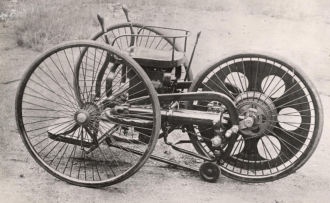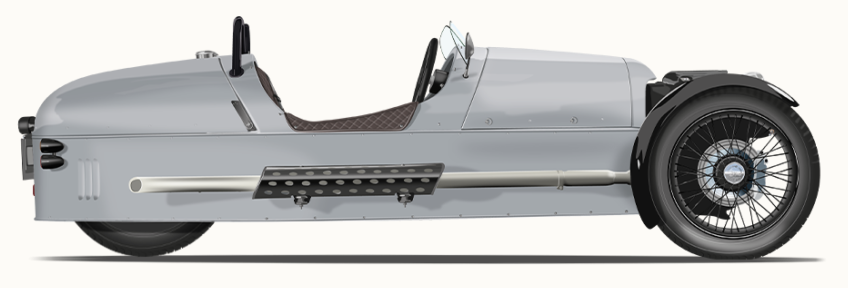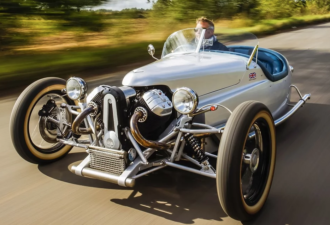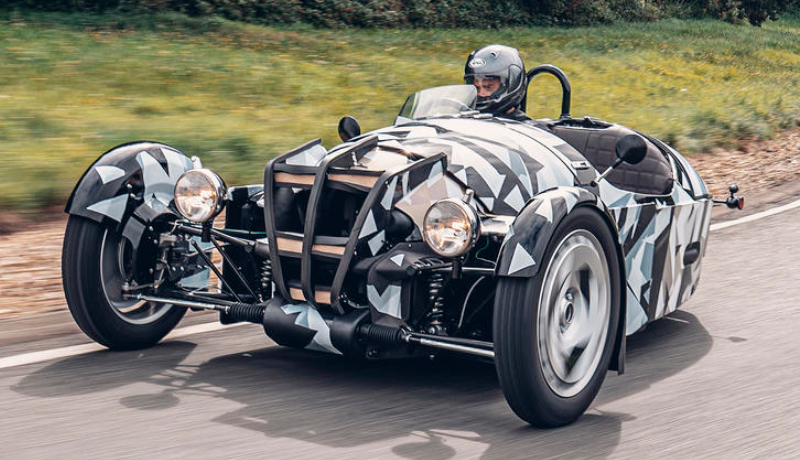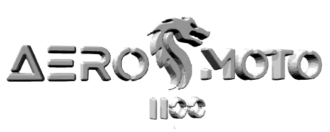This scratch-built “re-cycle” project was abandoned in 2022 due to global supply chain shortages and component inflation. The initial planning phase is presented here as an example of the kind of research required to launch a reconstituted historical vehicle using new and re-purposed technology.
At the turn of the last century, three-wheeled vehicles led the Cambrian-like evolutionary explosion that propelled motorized travel into the cultural mainstream.
The reverse tricycle configuration, a natural progression from the human-powered bicycle, was first conceived by the Englishman Edward Butler in 1884, two years before Karl Benz invented the first automobile. This early cyclecar (today often referred to as an autocycle) was powered by a remarkable experimental 600cc water-cooled flat twin four stroke engine.
Morgan three-wheeler
Henry Frederick Stanley Morgan was the first to commercialize the reverse tricycle at the November 1910 International Motor Cycle Show held in London. Marketed as the “Morgan Runabout” and powered by a single cylinder four-horsepower engine, the concept caught on quickly.
By 1912, the cyclecar movement had achieved enough traction for Morgan to found a company with his father and begin manufacturing in earnest. From its early racing heritage, technological improvements resulted in the 1928 Super Sport Aero that Morgan claimed was “the fastest three-wheeler in the world”.
Powered by a V-twin engine and a 2-speed gearbox, the Aero could achieve speeds of 80 MPH, very impressive given that most cars on the road struggled to reach 50 MPH. Between 1928 and 1931, the Super Sport Aero emerged in various formats and design variations, but the one that most reflects early automotive history sported the J.A.P. engine, a distinctive louvered enclosed beetleback rear, full circular front mudguards, and straight back side exhaust pipes.
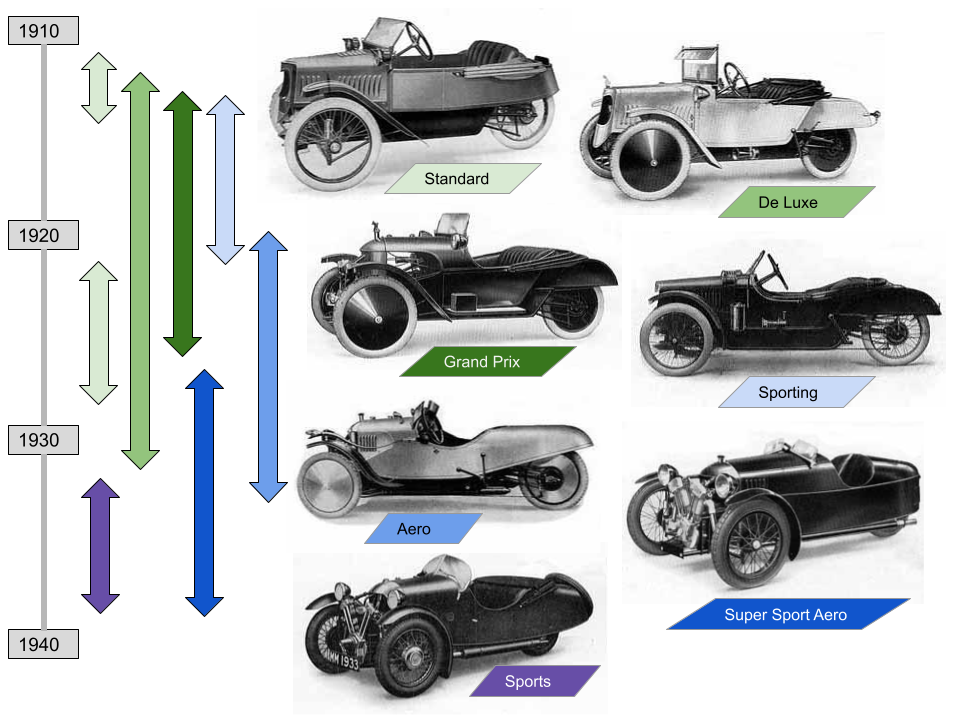
Morgan classic V-twin two-seat 3-wheelers (many variants were built; images are representative only)
The Super Sport Aero, the first Morgan to have a fully enclosed rear wheel, is now considered the apex of the vintage style with prominent headlights, large front spoke wheels, and its sleek wrap-around body. In 1933, despite the impact of the Great Depression, Morgan introduced a standardized chassis with detachable 18-inch wheels called the Sports model with a 3-speed gearbox and barrelback rear end designed to hold a spare wheel.

1933 Morgan Super Sport Aero three-wheeler with a V-twin Matchless engine (the “M” isn’t for Morgan)
Plagued by economic hardship and the limitations of various engine suppliers, Morgan experimented with a new Ford-powered Model F in 1934. A fire destroyed the coach building shop at the Morgan works in 1936, and a few months later Morgan lost his father who had been the company chairman. By 1938, production fell to only 110 three-wheelers before the onset of wartime restrictions quickly brought the original cyclecar era to an end.
Cyclecar reborn
A number of vendors have redesigned cyclecars with new technology in the classic style, led by the venerable Morgan Company that is still in business.
Morgan M3W
Morgan relaunched the 3-wheeler in 2011 with an S&S 1998cc V-twin engine coupled to a Mazda 5-speed gearbox (while production has now ceased, a new inline-3 version has been announced for 2022). A recent August 2021 auction of a 2015 Morgan on Bring A Trailer went for $42,550. View Jay Leno’s review of a 2014 Morgan 3-wheeler.
In all, Morgan built about 2,550 M3Ws between 2011 and 2021 (about 250 per year, or roughly 25% of Morgan’s total annual vehicle production).
Bottom line: to longer in production.
Pembleton
The Pembleton Motor Company has manufactured about 500 aluminum body cyclecars — both complete and in kit form — resembling the Morgan Sports and Super Sport Aero since 1999 (about 25 per year).
Based on the 4-speed Citroën CV2 transaxle, these front wheel drive cyclecars have in-board front disc brakes supported by a Citroën-like front suspension system. As a result, the V-twin engine is “exposed” since the block rests on a bottom ladder chassis design. This minimalist structure results in a very low curb weight — under 660 lbs — enabling the less powerful 50 HP Moto Guzzi engine from the V7 III Stone model to generate a 100 MPH top speed.
Bottom line: a used Citroën CV2 transaxle is increasingly difficult to source.
Triking
The Triking “modernizes” the cyclecar concept by streamlining the body and substituting fiberglass for the traditional aluminum.
Powered by post-2010 Moto Guzzi V-twin engines — either the popular 1100 or 1200cc sizes — the Triking adopts the recent mono shock Guzzi swing arm together with a hydraulic clutch and 5-speed gearbox (plus reverse). Available in either fully built or kit configurations, the front of the Type 4 is decidedly futuristic.
The Triking is heavier than the Pembleton — about 860 lbs curb weight — with a considerably wider track than the vintage specification; 1670mm to 1750mm track width options versus about 1300mm found in classic models.
Bottom line: body design and vehicle track departs from the vintage appearance.
JZR
Launched in the 1980’s by John Ziemba Restorations in Lancashire, UK, as a Morgan replica kit, this design was powered by various engines including the Honda CX, Moto Guzzi, Honda Pan European, and Harley Davidson. A steel chassis enclosed with a fiberglass bonnet and rear section closely followed the vintage Morgan Aero design. The front suspension and brakes, based on a Chevrolet Chevette, utilized tubular A arms and coil over shocks and were mated to a Ford Escort MK2 rack and pinion steering rack. Approximately 320 JZR kits were produced.
Bottom line: company is apparently no longer operating.
J. A. Prestwich Japster
Built on a Triking chassis, the Japster was powered by a bespoke 85-hp V-twin with a BMW bevel gear and Ford Mark 9 five-speed gearbox. This unique engine, a period correct re-creation of the 1920s J.A.P. JTO, featured a 1300cc block with thicker crankcases, ceramic-coated bores, and specialty castings from the same company that pioneered the original J.A.P. design. Curiously, while the Japster engine may be the closest historical match to original Morgans, Prestwich chose a cockpit and body design that departed significantly from the vintage look.
Bottom line: production ceased in 2014.
Aero Merlin
Arthur Rayner’s Aero Merlin was closely based on the Morgan Super Sport Aero. Like the Triking, the engine choice is the big block range of Moto Guzzi V-twins.
Rayner’s chassis used a space frame MIG-welded design with a robust front end that supported a twin wishbone suspension and rear wheel drive via the Guzzi swing arm and bevel gear. The body featured louvered aluminum panels with chrome fittings combined with fiberglass front scuttle, rear cover, and mudguards.
Bottom line: activity ceased in 2021.
V-twin engine tradition
The key to rejuvenating the vintage cyclecar in the style of the Morgan Super Sport Aero centers around the engine: the distinctive V-twin is a must.
The Morgan Company has struggled with this signature feature. Their revitalized 2011 model (M3W) retained the classic exposed engine look, but because regulatory approval of the S&S engine terminated in 2021, Morgan had to cease production.
Meanwhile, Morgan’s electric 3-wheeler concept (EV3) failed for technical reasons after four years of development presenting Morgan with an uncomfortable engine quandary, a sort of deja vu given Morgan’s frequent engine swap experiments in the 1920-38 period.
The new 2023 Morgan 3-wheeler is powered by Ford’s inline 3-cylinder, probably a modified 1.0L EcoBoost Fox turbocharged engine. This choice has huge exterior design implications since the lovely V-twin exposed frame is gone! To enclose the tower-like Fox substitute, the front of the body must be completed covered.
In fact, early Morgan design sketches telegraphed this direction as Morgan evolves away from the classic V-twin look, a big risk for the company that has long defined what the 3-wheeler should be.
So no one apparently will be carrying on the vintage V-twin cyclecar tradition!
Dating back to the 1880s, the V-twin design features two cylinder pistons sharing a common crankshaft arranged in a V configuration ranging from 20° to 170°. The most beneficial V angle for a V-twin engine is 90° because that achieves a perfect primary balance (but an uneven firing order) in popular Ducati, Moto Guzzi, Honda, and Suzuki motorcycles.
Apart from V angle, the other major design configuration is longitudinal versus transverse mounting on the frame.
Pioneered by the Indian Motorcycle Manufacturing Company of Springfield, Massachusetts, the longitudinal engine mounts with the V-shape positioned symmetrically to the frame making it suitable for a reverse trike mounting. Of all the many motorcycle air-cooled engines, only the Italian Moto Guzzi has a modern 90° angle longitudinal design.
Moto Guzzi
Since 1994, Moto Guzzi has manufactured a “big block” 1046cc California engine, just the perfect size to mirror the 1096cc J.A.P. in the original Morgan Super Sport Aero.
| Model Specifications | 1931 Aero J.A.P. LTZ | Moto Guzzi California 1100 |
|---|---|---|
| V angle | 60 degrees | 90 degrees |
| fuel delivery | twin carburetors | fuel injection |
| displacement | 1096cc | 1046cc |
| bore x stroke | 85.7 x 95.0 mm | 92.0 x 80.0 mm |
| horsepower max | 23 | 75 |
| cooling system | air or water | air |
| gearbox | 2- or 3-speed | 5-speed |
| horsepower max | 23 | 75 |
| top speed | 80 MPH | 115 MPH |
| curb weight | 950 lbs | 870 lbs |
| weight/power ratio1 | 41.3 | 11.6 |
1] by comparison, the weight/power ratio of a 2021 Ford Mustang with the high performance package is about 11.8.
Basically, for the same size footprint, the Moto Guzzi delivers three times the horsepower!
Founded in 1921, Moto Guzzi grew into Italy’s largest motorcycle manufacturer, but remains a financially vulnerable niche player in a worldwide industry. After a misguided moped bike investment, Guzzi emerged from bankruptcy in 1973 to launch the much admired 850 Le Mans (844cc) in 1976. The Le Mans engine was eventually expanded to 1046cc to power the series of popular California models first introduced in 1994.
Moto Guzzi California 1100 sound
In 1999 Guzzi once again suffered significant financial losses and was acquired by Aprilia in 2000. Changes in leadership and corporate strategy, including a poorly conceived product proliferation, compounded earlier errors. Piaggio acquired the company at the end of 2004. In light of all the financial turmoil, the most stable models to consider are those manufactured before 1999, namely the California 1100 series of 1994-97 or early California EV models.
Lanching the Aero Moto 1100
As described above, we intend to incorporate the big block Moto Guzzi V-twin engine into a design that reflects, but doesn’t replicate, the Morgan Super Sport Aero. In addition to the “recycled” donor Moto Guzzi 1046cc engine, the motorcycle’s drive train components will also be used with some modification.
Since our design will closely mirrors, more to less, the vintage Morgan Super Sport Aero and since we will be installing a Moto Guzzi 1046cc engine that is referred to as the 1100 (see the engine specification above) to power it, we think an appropriate name for our project is the “Aero Moto 1100”.
As with any bespoke vehicle that doesn’t exist until it is built and customized, our Aero Moto 1100 will face many decisions and problems to solve. We hope to strongly reflect the Art Deco sensibility that surrounded the original cyclecars, sticking to pre-war materials where we can — as little plastic as possible — and featuring the classic aluminum shell body shape, lots of polished metal, and a touch of leather and wood to reflect the aristocratic panache of last century’s 3-wheel racers.
We prefer the original beetleback curve in the rear instead of the later abrupt barrelback adaptation designed to hold a spare tire (a government requirement in Britain at the time). The spare tire becomes an anachronism, by the way, given how hard and dangerous it would actually be to change a tire on today’s highways.
This blog follows the cyclecar project from the very first step: finding the right motorcycle to “recycle” into a vintage 3-wheeler.
How to navigate
MAJOR TOPICS in the left column provides a dropdown list of all posts by category.
Below TOPICS, the left column has this shortcut bar:

Click the clock symbol for a listing of recent posts, starting with the most current one. Click the quote bubble symbol for a list of recent comments.
The default column view is the clock symbol, and each post is represented like this:
The top title is the category; if you click it, you’ll see a listing of all posts within that category. Below the category title is the post name; if you click it, you’ll go directly to that post.
